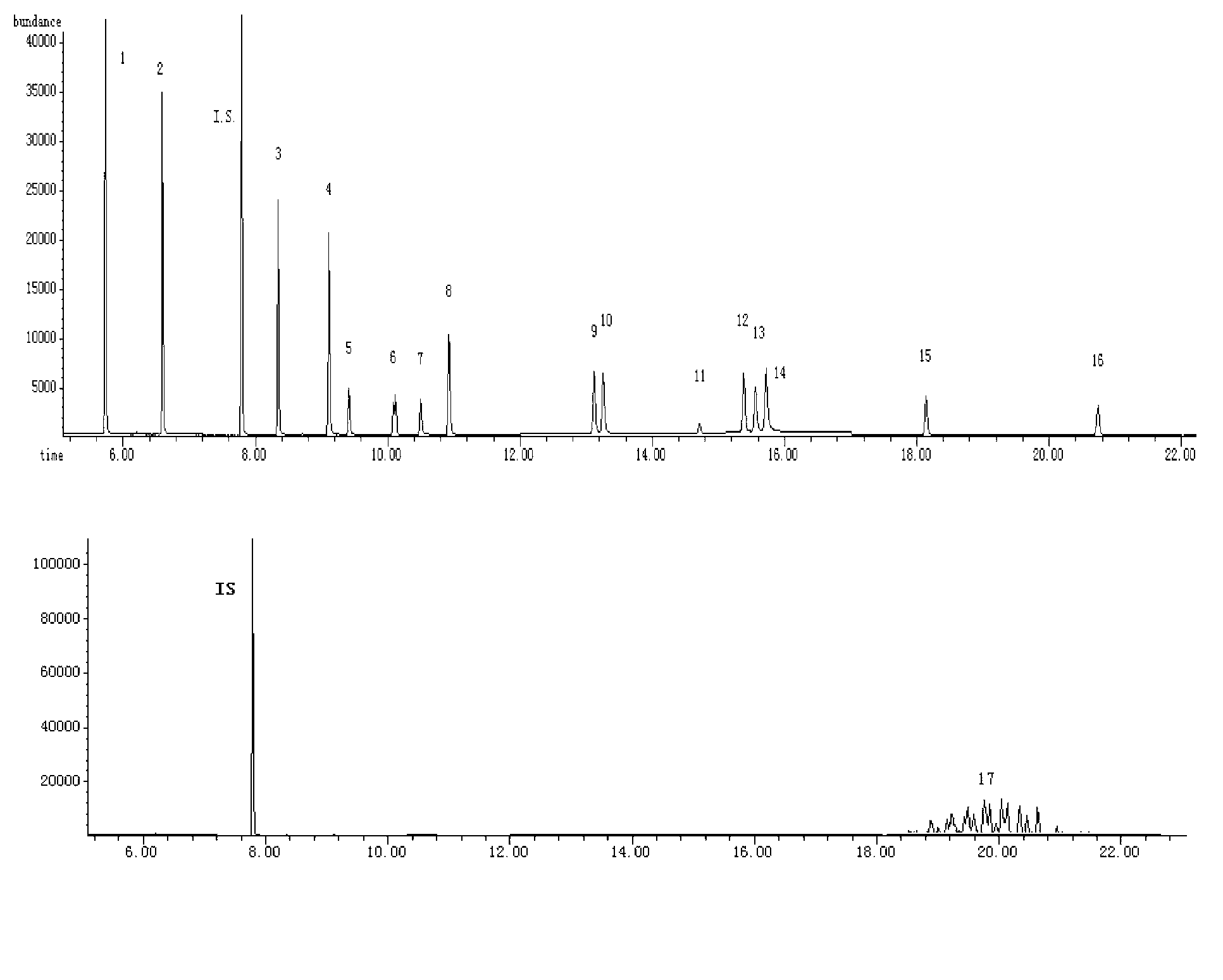Gas chromatography-mass spectrometry detection method of 17 phthalate compounds in printing ink
A technology for phthalic acid and ester compounds, which is applied in the field of gas chromatography-mass spectrometry combined detection, can solve the problem of no relevant reports on the detection of phthalic acid ester compounds, and achieves reduction of errors, improvement of sensitivity, and high recovery rate. Effect
- Summary
- Abstract
- Description
- Claims
- Application Information
AI Technical Summary
Problems solved by technology
Method used
Image
Examples
Embodiment 1
[0037] A gas chromatography-mass spectrometry detection method for 17 kinds of phthalates in printing ink, comprising the following steps:
[0038] Prepare the internal standard extraction solution: use benzyl benzoate as the internal standard standard and n-hexane as the extraction agent to prepare an internal standard stock solution with a concentration of 500 μg / mL, then pipette the internal standard stock solution into a volumetric flask, and use n-hexane Dilute to volume with alkane to obtain an internal standard extract with a concentration of 5.0 μg / mL. The specific preparation is as follows: Accurately weigh 2.5g of benzyl benzoate in a 100mL volumetric flask, dilute to the mark with n-hexane and mix well to obtain a solution with a concentration of 25.0mg / mL; accurately pipette 2mL of the above solution into a 100mL volumetric flask In the method, dilute to the mark with n-hexane and shake well to obtain an internal standard stock solution with a concentration of 500 ...
Embodiment 2
[0062] Present embodiment discusses result of the present invention, concrete implementation is as follows:
[0063] 1. The effect of the amount of water and ethanol on the extraction efficiency
[0064] Printing inks are mainly water-soluble and solvent-based inks and most of them are relatively viscous. In order to fully extract the sample, add an appropriate amount of water and ethanol (volume ratio 1:1) to dissolve and dilute the sample, and then add the extract for liquid extraction. liquid extraction. This experiment tested the influence of different amounts of water and ethanol on the extraction results of phthalates in printing inks. The results are as follows Figure 4 (The abscissa is the volume of water and ethanol added, and the ordinate is the measurement results of DBP and DEHP in the sample) as shown, from Figure 4 It can be seen that the extraction efficiency is the highest when adding 10-20 mL of water and ethanol (volume ratio 1:1). Therefore, this method...
Embodiment 3
[0118] In this example, specific samples will be analyzed.
[0119] The established method was used to determine the content of phthalates in 50 different printing inks. The chromatograms of phthalates in different samples and blanks are as follows image 3 Shown; 50 ink sample data are shown in Table 9.
[0120] Table 9 Contents of phthalates in different ink samples (mg / Kg) (all samples that were not detected are not listed)
[0121]
[0122]
[0123] Among the 50 ink samples surveyed, phthalates were detected in 45 samples to varying degrees, accounting for 90% of the total samples. Among the 16 phthalates, DEEP, DPP, BBP, DBEP, DCHP, diphenyl phthalate, DNOP, and DNP were all detected. Among the detected DMP, the highest content is 306.14mg / Kg, the highest DEP content is 55.32mg / Kg, DIBP is 2661.74mg / Kg, DBP is 20790.72mg / Kg, DMEP is 223.39mg / Kg, DHXP is 126.65mg / Kg Kg, DEHP is 30077.58mg / Kg.
PUM
| Property | Measurement | Unit |
|---|---|---|
| Concentration | aaaaa | aaaaa |
| Ionization energy | aaaaa | aaaaa |
Abstract
Description
Claims
Application Information
 Login to View More
Login to View More - Generate Ideas
- Intellectual Property
- Life Sciences
- Materials
- Tech Scout
- Unparalleled Data Quality
- Higher Quality Content
- 60% Fewer Hallucinations
Browse by: Latest US Patents, China's latest patents, Technical Efficacy Thesaurus, Application Domain, Technology Topic, Popular Technical Reports.
© 2025 PatSnap. All rights reserved.Legal|Privacy policy|Modern Slavery Act Transparency Statement|Sitemap|About US| Contact US: help@patsnap.com



